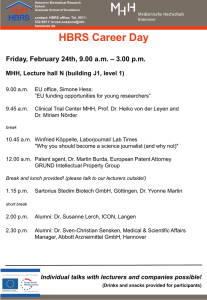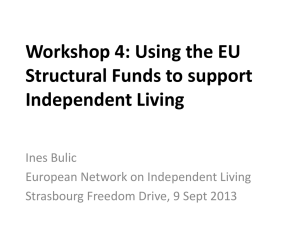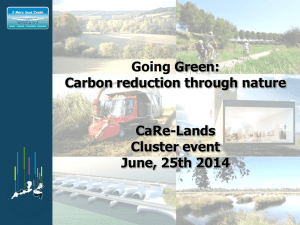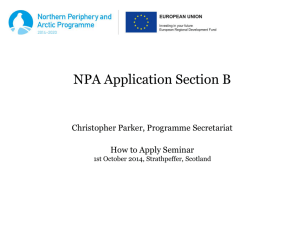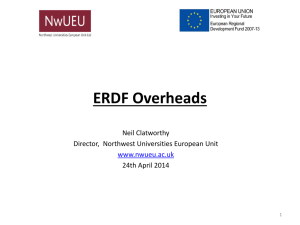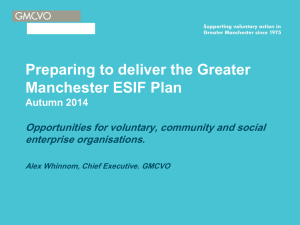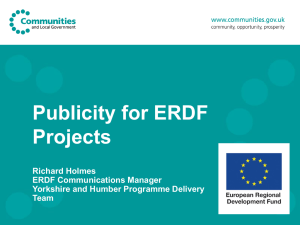KRONSBERG, HANNOVER: A model of sustainable urban community
advertisement
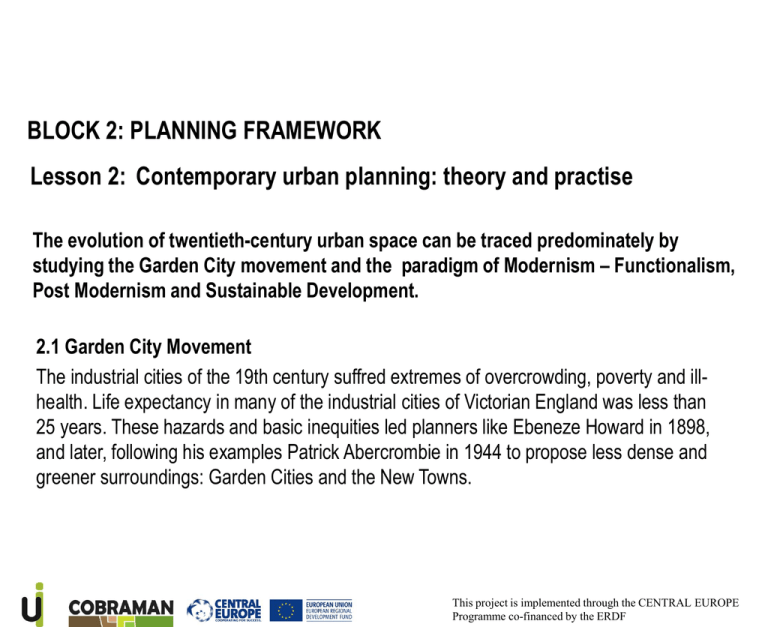
BLOCK 2: PLANNING FRAMEWORK Lesson 2: Contemporary urban planning: theory and practise The evolution of twentieth-century urban space can be traced predominately by studying the Garden City movement and the paradigm of Modernism – Functionalism, Post Modernism and Sustainable Development. 2.1 Garden City Movement The industrial cities of the 19th century suffred extremes of overcrowding, poverty and illhealth. Life expectancy in many of the industrial cities of Victorian England was less than 25 years. These hazards and basic inequities led planners like Ebeneze Howard in 1898, and later, following his examples Patrick Abercrombie in 1944 to propose less dense and greener surroundings: Garden Cities and the New Towns. This project is implemented through the CENTRAL EUROPE Programme co-financed by the ERDF Garden City Howards’s garden-city idea was based on integration of town and country attributes. His formula garden city for 32.000 people consisted of 1.000 acres of urban land, surrounded by 5.000 acres of agricultural land. The radial concentric plan focused on a central core (public buidings: town hall, theater, library, hospital,..) soranded by central park. The city was organised around a series of landscaped boulevards and avenues. Factories were located on the perimeter of the town with good access to an infrastructure corridor (railway, motorway). Allotments were located as a bafer zone between factories and country side – large farms. Principls of Garden City’s growth (left) and Garden City Layout Source: Trancik, 1986; Pogačnik, 1999 This project is implemented through the CENTRAL EUROPE Programme co-financed by the ERDF Garden City Howard’s concept of parklike, soft space in cities was soon adopted by many planners of the early twentieth century and became a guideline of modern town planning movement in Europe and America. One of the best examples is the new town of Letchworth, England. Master plan was prepared by Barry Parmer & Reymond Unwin. The 1903 layout plan was based on the principles of land use defined areas for commercial and industrial development, varied residential districts and an agricultural belt. Letchworth, 1903 Source: Trancik, 1986; Pogačnik, 1999 This project is implemented through the CENTRAL EUROPE Programme co-financed by the ERDF REMEMBER The industrial cities of the 19th century suffred extremes of overcrowding, poverty and ill-health. These hazards and basic inequities led planners like Ebeneze Howard in 1898, and later his follower, to propose less dense and greener surroundings. Howards’s garden-city idea was based on integration of town and country attributes. His radial concentric plan focused on a central core (public buidings: town hall, theater, library, hospital,..) soranded by central park. The city was organised around a series of landscaped boulevards and avenues. Factories were located on the perimeter of the town with good access to an infrastructure corridor (railway, motorway). Allotments were located as a bafer zone between factories and country side – large farms. Howard’s concept of parklike, soft space in cities was soon adopted by many planners of the early twentieth century and became a guideline of Garden Cities’ and the New Towns’ movement in Europe and America. BLOCK 2: PLANNING FRAMEWORK Lesson 2: Contemporary urban planning: theory and practise 2.2 Modernism – Functionalism Modernism or rather the paradigm of Functionalism is based on ideals of pure forms and unbounded, flowing space. The ‘tower in the park’ was intended to break the urban block of the traditional city and give a newfound freedom to the urban residents. Functionalism was the architectural expression of the intellectual and aesthetic revolution in the early twentieth century that originated in the Bauhause school in Germany followed by De Stijl in Netherlands and French urban-design movement led by the famous architect Le Corbusier (see Trancik, 1986, 21-30 p.). The pioneers of the modern movement, the same as their predecessors Vitruvius, Leonardo de Vinci, Ebenezer Howard and others, proposed ideal cities that they imagined would create ideal societies. They turned to new technologies , industrial techniques and new build forms because they ‘offered creative freedom and the prospect of social improvements’ (Rogers, 1997:68). This project is implemented through the CENTRAL EUROPE Programme co-financed by the ERDF Functionalism Le Corbusier dominated modern architecture in the period from 1920 to 1960. His three urban design principles that influenced modern urban space design are following: (1) The open urban block that allows free flowing landscape, sun and light, (2) The vertical separation of movement systems, (3) The linear building as a large-scale urban element which define districts or social units. Le Corbusier’s aphorism for house was a ‘machine for living’ in which all elements without a direct function were eliminated. Le Corbusier’s City Governed by the Course of the Sun Source: Trancik 1986 This project is implemented through the CENTRAL EUROPE Programme co-financed by the ERDF Functionalism source: Trancik 1986 Freestanding buildings in straight, parallel rows, set on a wide, open plaza or green space, rigidly separated traffic systems and carefully zoned function (living, work, leisure) has been a main concept in shaping modern urban space. This project is implemented through the CENTRAL EUROPE Programme co-financed by the ERDF Functionalism Source: Trancik 1986 Le Corbusier’s figure-ground diagram on the Ville Radieuse compared to traditional urban block of Paris, New York and Buenos Aires dramatically illustrates the contrast between the traditional urban patterns of evolved city and the free flowing spatial structure proposed by Functionalist theorists. This project is implemented through the CENTRAL EUROPE Programme co-financed by the ERDF Functionalism Corbusier’s large-scale projects such as Plan Voisin in Paris (1925), La Ville Radieuse (1934) and the master plan for Algiers in the thirties, had significant impact on urban planning throughout the world. CIAM, Team 10 and other architects all around the world adopted Corbusier’s principles of urban space (Trancik, 1986:27). Corbusier’s Plan Voisin for Paris (1920) illustrates the contrast between traditional urban patterns and the urban design of Modernism. Linear and nodal buildings define districts or social units over an open ground plan. Source: Trancik 1986 This project is implemented through the CENTRAL EUROPE Programme co-financed by the ERDF Proposal for renewal of Paris centre: Plan Voisin,1925 -1937 source: Košir et al 2007 Functionalism The purified façade, the geometry of squares and cubes and a regularised ground plan usually as a grid system where the design principles of Functionalism that had a major influence on urban design well into to 1970s. The grid, which has functioned as an easily applied mechanical method for organising urban forms from ancient Greek (e.g. Hippodamus’ plans for Millet and Priena) and Roman towns, has the advantage of flexibility and expandability. According to Trancik (1986:31) the effectiveness of the grid as an organizing system really depends on whether it is used to connect or separate different elements. The Functionalist approach was to use it to differentiate places and activities. Most of the land use plans upon each ‘large parts’ of our cities were built (e.g. large housing estates) were prepared in 1960s on the bases of Functionalist concept. Good examples of implementation of the Functionalist theory in planning practice are the new towns: Chandigarh (1950s), Brazilia (1960s), Milton Keynes (1970s). New towns: Chandigarh Le Corbusier concept for urban development is based on a grid system, with a comercial centre located in the crossroad of the two main axes, one to the Capitol (government centre) and other to the University. The capitol, the university the market and the industrial zone are set apart to form the city’s grid. Le Corbusier, Plan of Chandigarh, India source: Trancik 1986 This project is implemented through the CENTRAL EUROPE Programme co-financed by the ERDF New towns: Chandigarh Within the urban grid, in the middle of the urban blocks is located the green areas grid. In these green open spaces are located the socio-cultural amenities buildings such as schools, kindergardens, health centres, community centres... Chandigarh: Housing unit source: Maksimović, 1980 This project is implemented through the CENTRAL EUROPE Programme co-financed by the ERDF New towns: Chandigarh New towns: Brasilia Costa: Brasilia, 1956 source: Pogačnik, 1999 Goals for a new capital city in central Brazil: •Security – a safe city •Development hub – to bring economy into central Brazil, more homogeneous distribution of the population •Centralization – the federal administration centre Vir: Pogačnik, 1999 This project is implemented through the CENTRAL EUROPE Programme co-financed by the ERDF New towns: Brasilia The makers of Brasilia’s master plan - pilot plan, the Modernism trio: Lucio Costa, planer, Oscar Niemeyer, architect, Burle Marx, landscape architect Monumental axis National Congress New towns: Brasilia Neighborhood unit ‘super-block’ comprise (photo top-right): 1 residental superblocks, 2 local shops, 3 church, 4 school, 5 neighborhood club, 6 healthcare unit, 7 kindergarden, 8 library, 9 movie / theater. The pilot plan has in total 120 super-blocks, each 250mx250m for 2.500-3.000 people, density of 50p/ha. New towns: Milton Keynes Milton Keynes (population 250.000) developed in 1970’s, as a contemporary application of Functionalism, is designed around a uniform grid of roads spaced at one-kilometer intervals. Within each cell of grid there is room for approximately 500 dwelling units. The Master Plan shows the organisation of activities: hierarchy of centres (e.g. new city centre, centres, local activity centres), secondary schools, higher education campus, health campus, residental and industrial areas, parks.. Milton Keynes Master Plan source: Trancik 1986 This project is implemented through the CENTRAL EUROPE Programme co-financed by the ERDF New towns: Milton Keynes Milton Keynes Master Plan: Land use source: Milton Keynes Development Corporation This project is implemented through the CENTRAL EUROPE Programme co-financed by the ERDF New towns: Milton Keynes Milton Keynes’s low density and strong motocar orientation create a suburban quality that is more American in character than British. FUNCTIONALISM: Large housing estates Often abused and misunderstood the Functionalist concept ‘has resulted in buildings as isolated objects floating freely on useless plazas and unattractive parking lots’ (Trancik, 1994:27). This can relate also to the large housing estates built in the 1950s, 1960s and 1970s. Today, most of these areas are in need of comprehensive regeneration. This project is implemented through the CENTRAL EUROPE Programme co-financed by the ERDF Litostroj, Ljubljana: housing estate built in the 1950s in the Functionalist design theory. Fuzine, Ljubljana: large housing estate built in the 1970s in in need of comprehensive regeneration. REMEMBER Modernism or rather the paradigm of Functionalism is based on ideals of pure forms and unbounded, flowing space. Functionalism was the architectural expression of the intellectual and aesthetic revolution in the early twentieth century that originated in the Bauhause school in Germany followed by De Stijl in Netherlands and French urban-design movement led by the famous architect Le Corbusier. Le Corbusier’s three urban design principles that influenced modern urban space design are following: the open urban block, the vertical separation of movement systems, the linear building as a large-scale urban element which define districts or social units. Le Corbusier’s aphorism for house was a ‘machine for living’ in which all elements without a direct function were eliminated. Corbusier’s large-scale projects such as Plan Voisin in Paris (1925), La Ville Radieuse (1934) and the master plan for Algiers (1930s), had significant impact on urban planning throughout the world. Freestanding buildings in straight, parallel rows, set on a wide, open plaza or green space, rigidly separated traffic systems and carefully zoned function (living, work, leisure) has been a main concept in shaping modern urban space. Most of the land use plans upon each ‘large parts’ of our cities were built (e.g. large housing estates in 1950s1970s) were prepared on the bases of this Functionalist concept. Today, most of these areas are in need of comprehensive regeneration. Good examples of implementation of the Functionalist theory in planning practice are the new towns: Chandigarh (1950s), Brazilia (1960s), Milton Keynes (1970s). BLOCK 2: PLANNING FRAMEWORK Lesson 2: Contemporary urban planning: theory and practise 2.3 Postmodernism In the mid-1960s and early 1970s there have been several groups of architects who have critically examined the Functionalist paradigm: Robert Venturi, USA, Aldo Rossi, Italy, Ricardo Bofill, Spain, brothers Leon and Robert Krier, Luxembourg. A new Rationalism or Postmodern movement looks at historic models of towns for inspiration, promotes a concept for public open space and considers context and regionalism in the design of building forms or build environment. Venturi reinterpreted the popular Miss van der Rohe phrase ‘less is more’ to read ‘less is bore’, ‘emphasizing that everyday, ordinary space should not be stripped of its cultural meaning’ (Trancik, 1994:37). Critical examination of the Functionalist paradigm: land use zoning Source: Krier, 1984 This project is implemented through the CENTRAL EUROPE Programme co-financed by the ERDF Urban space design Source: Krier, 1984 This project is implemented through the CENTRAL EUROPE Programme co-financed by the ERDF Postmodernism Source: Krier, 1984 This project is implemented through the CENTRAL EUROPE Programme co-financed by the ERDF Bitnje, Kranj, Slovenia: postmodern concept of the new housing development. Housing estate built as a town. Source: Kaliopa Dimitrovska Andrews, Saša Dalla Valle, 1984 Bitnje: urban concept structures, Slovenian national urban design competition, 1984 , 1st prize build structure traffic structure green space structure Source: Kaliopa Dimitrovska Andrews, Saša Dalla Valle, 1984 Zupančičeva jama, Ljubljana: postmodern urban design layout REMEMBER Critical examination of the Functionalist paradigm revolve to development of new planning theory: a new Rationalism or Postmodern. Postmodern movement looks at historic models of towns for inspiration, promotes a concept for public open space and considers context and regionalism in the design of building forms or build environment. Venturi reinterpreted the popular Miss van der Rohe phrase ‘less is more’ to read ‘less is bore’. In continuation the main features of Modernisme and Postmodernism planning theory are given. REMEMBER Main features MODERNISM POSTMODERNISM Concept “tower in a park” “house is a machine for living” “Less is more”/ Mies van der Rohe Concept “back to historic models of city” “promotion of public open space” “Less is bore” / Venturi Land use zoning – separation of activities Mixed uses -reintegration of activities Open urban block layout Perimeter (closed) urban block layout Vertical separation of movement systems Mixes movement system Building typology: linear building in rows, standardisation, universal ‘modern’ style Variety in building forms design, cinsideration of context and regionalism in the design of build environment This project is implemented through the CENTRAL EUROPE Programme co-financed by the ERDF movements / groups / author MODERNISM Bauhaus (1918) Gropius, Brener, Van der Rohe,... De Stijl (1920) Mondrian, Van Doesburg, Rietweld,.. POSTMODERNISM Venturi, Leon and Robert Krier, Rowe, Bofil, Jencks,.. Le Corbusier (1920-1960) Team 10 (1950) Alison and Peter Smithson, Bakema,.. Ruski konstruktivizem (19181930) Miljutin, Vesnin CIAM (Congrès International D’Architecture Moderne 1928), Aten’s charter 1934 This project is implemented through the CENTRAL EUROPE Programme co-financed by the ERDF BLOCK 2: PLANNING FRAMEWORK Lesson 2: Contemporary urban planning: theory and practise 2.4 Sustainable Development The United Nations report ‘Our Common Future’ proposed the concept of ‘sustainable development’ as the backbone of global economic policy: ‘we should aim to meet our present needs without compromising future generations ...’ (Rogers, 1999:5) The ultimate aim of sustainable development is to leave to future generations a stock of natural capital that equals or even exceeds our own inheritance (e.g. an effective ozone layer, clean air, fresh water,a clean sea, fertil land, diversity of species,..) Environmental sustainability becomes the guiding principles of modern urban design, as a half of the world’s population (aprox. 3 billions) live in cities and in forty years’ time it may rise even to threequarters (aprox. 7,5 billions). This project is implemented through the CENTRAL EUROPE Programme co-financed by the ERDF SUSTAINABLE DEVELOPMENT Cities must be viewed as ecological systems. Their design and management should be a circular ‘metabolism’ process, where consumption is reduced by implementing efficiencies and where re-use of resources is maximised. To achieve this a new form of comprehensive holistic urban planning approach is needed. The concept of a ‘Compact City’ model, a dense and socially diverse city where economic and social activities overlap can bring major ecological benefits. The creation of the modern Compact City demands the rejection of singlfunction development with the domination of the car. Source: Rogers, 1999 This project is implemented through the CENTRAL EUROPE Programme co-financed by the ERDF SUSTAINABLE DEVELOPMENT The Compact City addresses the following issues: 1. city grows around centres of social and comercial activity located at public transport nodes, 2. these nodes of mixed uses provide the focal points around which neighbourhoods develop, the residental densities decreasing with the distance from transit stop, 3. each neighbourhood has its own parks and public spaces accommodating a diversity of overlapping private and public activities. sourc: Rogers, 1999 This project is implemented through the CENTRAL EUROPE Programme co-financed by the ERDF The sustainable city is: A Just City fairly distribution of justice, food, shelter, education, health; partcipation in government A Beautiful City art, architecture and landscape spark the imagination.. A Creative City open-mindedness and experimentation..; fast response to change An Ecological City balanced landscape and build development, resource-efficient infrastructures A City of Easy Contact A public realm to encourage community; face-to-face and electronic information A Compact and Polycentric City dense urban structure, maximises proximity, protects countryside A Diverse City overlapping activities create animation, inspiration and foster vital public life source: Rogers, 1999:169 This project is implemented through the CENTRAL EUROPE Programme co-financed by the ERDF KRONSBERG, HANNOVER: A model of sustainable urban community New city district of Hanover, Germany, for 15.000 people (6.000 dwellings), next to the World Exposition grounds, is built on the principles of sustainable development based on the Rio de Jeneiro conference Agenda 21. It was EXPO 2000 that enabled the local authority to implement the planning. The land use plan based on the international planning competition (1992) was approved by the City Council in 1994. source: Hannover Kronsberg Handbook, Planning and realisation, Landeshauptstadf Hannover, 2004 KRONSBERG, HANNOVER: A model of sustainable urban community The design of this EXPO settlement, along the new tram line to the Expo grounds, considers ecological, urban design and socio-economic and cultural issues: ECOLOGICAL OPTIMISATION CITY AS A GARDEN CITY AS A SOCIAL HABITAT Applying planning for sustainability placed considerable obligations on all stakeholders to secure the highest possible quality of life and to use natural resources sparingly. source: Hannover Kronsberg Handbook, Planning and realisation, Landeshauptstadf Hannover, 2004 KRONSBERG: URBAN DEVELOPMENT CONCEPT URBAN DESIGN CONCEPT SOCIO-CULTURAL AMENITIES COMPACT LAYOUT BALANCED SOCIAL MIX OF FUTURE RESIDENTS MIXED USE: RESIDENTIAL AND COMMERCIAL RESOURCE-EFFICIENT CONSTRUCTION CONSULTATIVE PLANNING PROCEDURES TRAFFIC MINIMALISATION CONCEPT tram route D all amenities within easy walking distance cycle priority route parking space restrictions OPEN SPACE QUALITY courtyards avenues neighbourhood parks green corridors district park ECOLOGICAL STANDARDS CENTRAL FACILITIES - arts, community and advice centre - church and neighbourhood centre - health centre, shops SOCIAL INFRASTRUCTURE - ‘kinderhouse’ with community bakery - kindergardens - primary school & middle/ secondary school - ‘FOKUS’ housing project - ‘Habitat’ international housing project - decentralised support for senior citizens - space allocation for community use NUTRITION - market, Kronsberg Farm ENVIRONMENT ENERGY energy use optimisatio district heating systems low energy buildings electricity saving measures use of renewal energy& innovative technologies WATER rainwater management concept drinking water economy measures WASTE ecologically compatible building materials building waste concept domestic and commercial waste concept SOIL soil management inherited pollution - removal or containment ENVIRONMENTAL COMMUNICATIONS KUKA - Kronsberg Environmental Liaison Agency This project is implemented through the CENTRAL EUROPE source: Hannover Kronsberg Handbook, Planning and realisation, Landeshauptstadf Hannover, 2004by the ERDF Programme co-financed KRONSBERG, HANNOVER: A model of sustainable urban community Geometrical form of the urban design layout is mainly derived from its alignment with the new tram line and parallel developmnet along the contour of Kronsberg hill. The first phase of the settlement is organise in two housing clusters north and south (total 6.000 dwellings), each one with a green area – the park in the centre and a local centre in between. In the spirit of planning for sustainability, close links between living and working in the vicinity are proposed. The grid layout of the blocks, the avenue-like streets and the open space planning unite many different construction forms and architectural styles in a harmonious townscape. The development structure follows the principle of decreasing density, the highest FSI 1.2 (4-5 storey blocks) along the main access road, which decrease approaching the countryside. This project is implemented source: Hannover Kronsberg Handbook, Planning and realisation, Landeshauptstadf Hannover, 2004 through the CENTRAL EUROPE Programme co-financed by the ERDF KRONSBERG, HANNOVER: A model of sustainable urban community This project is implemented through the CENTRAL EUROPE source: Hannover Kronsberg Handbook, Planning and realisation, Landeshauptstadf Hannover, 2004 by the ERDF Programme co-financed KRONSBERG, HANNOVER: A model of sustainable urban community Environmental compatibility and the compact community were the paramount aims of transport planning. A new district tram service (distance to tramstop max. 600m) links the settlement with the city centre. A bus route provides other cross-connections. The main motorised traffic flow is channelled in the avenue along the tramline in the age of development. The street layout with a designated cycle street permits no through traffic (30kph zones). This project is implemented through the CENTRAL EUROPE source: Hannover Kronsberg Handbook, Planning and realisation, Landeshauptstadf Hannover, 2004 Programme co-financed by the ERDF KRONSBERG, HANNOVER: A model of sustainable urban community Car parking spaces are mainly arranged in small areas, either set into the hill-side or at ground level. Around a third of car parking is underground. Parking space ratio is very low 0,8 per apartment plus 0,2 for parking spaces on the public streets. Along the tramline and the main access road shops and offices have been planned. At the mid-point of the first phase development these uses are concentrated in a small local centre: a shopping centre, the ‘KroKus’ arts and community centre, a health centre and a church. This project is implemented source: Hannover Kronsberg Handbook, Planning and realisation, Landeshauptstadf Hannover, 2004 through the CENTRAL EUROPE Programme co-financed by the ERDF KRONSBERG, HANNOVER: A model of sustainable urban community source: Hannover Kronsberg Handbook, Planning and realisation, Landeshauptstadf Hannover, 2004through the CENTRAL EUROPE This project is implemented Programme co-financed by the ERDF KRONSBERG, HANNOVER: A model of sustainable urban community This project is implemented source: Hannover Kronsberg Handbook, Planning and realisation, Landeshauptstadf Hannover, 2004 through the CENTRAL EUROPE Programme co-financed by the ERDF KRONSBERG, HANNOVER: A model of sustainable urban community This project is implemented through the CENTRAL EUROPE source: Hannover Kronsberg Handbook, Planning and realisation, Landeshauptstadf Hannover, 2004 Programme co-financed by the ERDF KRONSBERG, HANNOVER: A model of sustainable urban community Planning for social balance implies a multiplicity of housing, dwellings typology and financial forms. The concept provides both privately financed owner-occupied apartments or apartments to rent and publicly subsidised apartment. 200 owner-occupied terraced houses were also planned. The conditions for publicly subsidised accomodation eligibility had to be relaxed in order to ensure the social planning goals of a balanced population mix. The income limit, particularly, was significanty raised (for first tenants only). source: Hannover Kronsberg Handbook, Planning and realisation, Landeshauptstadf Hannover, 2004 through the CENTRAL EUROPE This project is implemented Programme co-financed by the ERDF KRONSBERG, HANNOVER: A model of sustainable urban community source: Hannover Kronsberg Handbook, Planning and realisation, Landeshauptstadf Hannover, 2004 The main goal of energy efficiency optimisation concept is to reduce CO2 emissions by at least 60% compared to current standards for conventional residential buildings. Reduction of energy consumption is achieved through low energy house building methods, optimised energy provision by a differentiated district heating system fed by two central cogeneration plants, the integration of wind and solar power, and by specific measures on the consumer side. This project is implemented through the CENTRAL EUROPE Programme co-financed by the ERDF KRONSBERG, HANNOVER: A model of sustainable urban community Solarcity is an exemplary project, clearly demonstrating the sustainability of extensive solar energy provision for a housing development. Has been made possible with grant support from the federal and state governement and the EU.To arrange all houses facing south due to optimisation of the solar efficiency would create a monotonous schematic layout. This project is implemented source: Hannover Kronsberg Handbook, Planning and realisation, Landeshauptstadf Hannover, 2004through the CENTRAL EUROPE Programme co-financed by the ERDF KRONSBERG, HANNOVER: A model of sustainable urban community source: Hannover Kronsberg Handbook, Planning and realisation, Landeshauptstadf Hannover, 2004 40% of the Solarcity apartments’ entire energy needs for space heating and hot water is met by the sun. Heat collected in summer is fed into a thermal storage tank (2.750m3, 11m high). When the heat in the storage tank is no longer sufficient, the system taps into the district heating network. The tank rises 4,5m above ground level, and its surface area of 530m2 has been landscaped as a This project is implemented through the CENTRAL EUROPE play and climbing hill. Programme co-financed by the ERDF KRONSBERG, HANNOVER: The microclimate A model of sustainable urban community zones have large areas of glass between heat storage walls completing the external structure. Serves as a buffer (20% less heat loss through transmition). Staircases and kitchens look out on the microclimate zone, while all living rooms face outwards onto spacious balconies with sliding sunscreens. The microclimate roof is made up of three layers of ETFE sheeting; the middle and upper layers are printed with a reflective pattern. In summer these two layers form a reflective roof. In winter they are apart, so the sun can pass. This project is implemented through the CENTRAL EUROPE Programme co-financed by the ERDFHannover, 2004 source: Hannover Kronsberg Handbook, Planning and realisation, Landeshauptstadf KRONSBERG, HANNOVER: A model of sustainable urban community source: Hannover Kronsberg Handbook, Planning and realisation, Landeshauptstadf Hannover, 2004 The ‘Lummerlund’ passive houses are heated and cooled all year round without a separate heating distribution system using passive technologies. In winter, if neccessary, each house can tap into the district heating system, when warm air is distributed by the ventilation system. Supplementary heating needs are around 15kWh per m2; a passive house consumes one-seventh of the heating energy of a conventional new house. This project is implemented through the CENTRAL EUROPE Programme co-financed by the ERDF KRONSBERG, HANNOVER: A model of sustainable urban community This project is implemented through the CENTRAL EUROPE Programme co-financed source: Hannover Kronsberg Handbook, Planning and realisation, Landeshauptstadf Hannover, 2004 by the ERDF KRONSBERG, HANNOVER: A model of sustainable urban community District heating regulation was based on criteria of cost and environmental impact. Central heating provision via a wide district heating network fed by gas-powered central heat and power cogeneration plants was the best combination in view of low running costs, low CO2 emissions and resource conservation. This project is implemented through the CENTRAL EUROPE Programme co-financed source: Hannover Kronsberg Handbook, Planning and realisation, Landeshauptstadf Hannover, 2004 by the ERDF KRONSBERG, HANNOVER: A model of sustainable urban community source: Hannover Kronsberg Handbook, Planning and realisation, Landeshauptstadf Hannover, 2004 KUKA, environmental liaison agency, monitores and promotes the ecological development of the Kronsberg sustainable city district in the areas of energy, waste, soil, water, landscape, farming and mobility. Working with its partners, KUKA provides a comprehensive skilling and qualification programme used in ecological advisory and training measures for planners, craft workers, and This project is implemented through the CENTRAL EUROPE residents of Kronsberg. Programme co-financed by the ERDF KRONSBERG, HANOVER: URBAN PLANNING INSTRUMENTS Development Planning, Master Plan, Overall Coordination City of Hannover Planning Group for the World Exposition (J/2000) Land consolidation City of Hannover: IDB (private sector developers): owned ²/3 of the development area owned 1/3 of the development area IDB City - urban development contract - access and utilities contract Call for tenders for building plots selection of developers Urban development study for the IDB area Project development Kronsberg Consultative Council approval by J/2000 Land sale contracts Project development/ land sale contracts IDB District Architect Kronsberg Consultative Council source: Hannover Kronsberg Handbook, Planning and realisation, Landeshauptstadf Hannover, 2004 through the CENTRAL EUROPE This project is implemented Programme co-financed by the ERDF REMEMBER The ultimate aim of sustainable development concept is to leave to future generations a stock of natural capital that equals or even exceeds our own inheritance (e.g. an effective ozone layer, clean air, fresh water,a clean sea, fertil land, diversity of species,..) Environmental sustainability becomes in 1990s the guiding principles of modern urban design introdusing the Compact city concept. The concept of a ‘Compact City’ model, a dense and socially diverse city where economic and social activities overlap can bring major ecological benefits. The Compact City addresses the following issues: • city grows around centres of social and comercial activity located at public transport nodes, • these nodes of mixed uses provide the focal points around which neighbourhoods develop, the residental densities decreasing with the distance from transit stop, • each neighbourhood has its own parks and public spaces accommodating a diversity of overlapping private and public activities. Kronsberg, the city district of Hanover, Germany is a model of sustainable urban community, built on the principles of sustainable development. The design of this EXPO settlement, along the new tram line to the Expo grounds, considers ecological, urban design, socio-economic and cultural issues. Questions: Q 1 What was the movement of Urban Planning that evolved in the early part of the twentieth century? a. Short life expectancy of the 19th Century, overcrowding, and poverty b. The Garden City Movement Q 2 Who was the early conceiver of solutions to the 19th Century overcrowding of cities? a. Ebenezer Howard b. Le Corbusier Q 3 What were the main ideals of Modernism? a. Pure forms and flowing space, b. The Tower in the Park c. Access mode separation Q 4 What was Le Corbusier’s ‘aphorism’ for the house a. A comfortable home b. A machine for living in c. A good environment Q 5 What were the three design principles of Le Corbusier? a. The open urban block , The separation of movement systems, Linear buildings as large scale Urban Elements b. Open space, High density blocks, Separation of pedestrians and vehicular traffic Questions: Q 6 What were Le Corbusier’s three principle schemes ? a. Plan Voisin, La Ville Radiuese, and the master plan for Algiers b. The grid system as in Chandigrah, Brasilia and Milton Keynes c. The neighbourhood concept as developed in Brasilia Q 7 What were the main features of Postmodernism concept? a. ‘town in a park’, land use zoning, building typology standardisation b. ‘back to historic model of city’, mixed uses, variety in building forms design c. ‘back to traditional model of the city’, land use zoning, high density blocks Q 8 What is the ultimate aim of sustainable development? a. to leave to future generations a stock of natural capital that equals or even exceeds our own inheritance b. to leave to future generations a stock of urban/built capital that exceeds our own inheritance c. to leave to future generation a prosperous urban cultural heritage Q 9 What are the three main issues of the ‘Compact city ‘ model? a. city grows around activity centres located at the public transport nodes, each neighbourhood has its own parks and public spaces, the residential densities decreases with the distance from the public transport node b. city has high residential densities, each neighbourhood has its own parks and public spaces, good car accessibility
